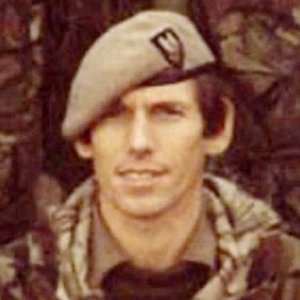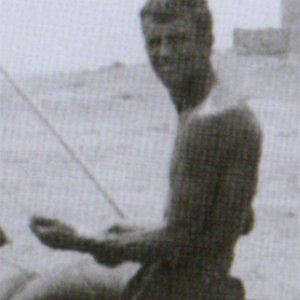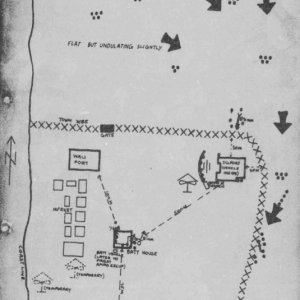CITATION:
Military Medal :
Mirbat is a medium sized and important fishing town lying some 25 miles East of Salalah. It is wired in and has a small military garrison of local gendarmerie and Askars, the latter being equivalent to home guard. There was an SAS contingent in the town.
There has been no major attack on the town or Mirbat since operations commenced in Dhofar some two years ago until the night of the 19th July. On this night the communist insurgents decided to mount, against Mirbat, the largest most determined and best planned attack that they have launched in the whole campaign. From captured enemy personnel it has since become clear that they were confident of their success and that had they captured the town they intended to occupy it permanently and establish a seat of communist government in Dhofar. The political implications of such a dramatic turn of events need no further expansion.
At 0530 hours on the morning of the 19th July mortars started to rain in on the Mirbat Garrison. The Garrison was stood to and under Captain Kealy's direction commenced the battle for the town. For over 4 hours the communists pressed home their attack; they infiltrated the town; they destroyed the stone defences with Rocket Launcher and Mortar fire; they concentrated a major effort against the SAS personnel in the town; they closed to grenade range and fought with a ferocity, tenacity and blind dedication that is the mark of all Communist shock troops. They launched this attack with an estimated 250 men against a small garrison town whose defence was designed to repel attacks from no more than a dozen men acting without determination. It was only after 4 hours of continual and ferocious fighting that they finally admitted defeat and withdrew leaving behind some 40 wounded and killed. A subsequent radio intercept indicates that they suffered at least 86 casualties and subsequent reports indicate that this figure may be as high as 100 or more.
As stand-to positions were occupied Cpl Bennett immediately directed a counter-bombardment with the one 80 mm mortar available to the SAS. Despite the intensity of the fire Bennett climbed on to an exposed position on the roof of the SAS house so that he might better direct the mortar and ascertain the movements of the enemy. At an early stage Captain Kealy left the position for the Dhofar Gendarmerie Fort leaving Cpl Bennett in charge of the remaining 4 SAS soldiers; the mortar and the vital radio communications with Salalah. For the next 4 hours Bennett acted as Commander of the mortar detachment and as senior liaison officer with Salalah and the supporting SOAF strike forces. Although he had communications with Captain Kealy these were spasmodic due to the intensity of the fighting in Captain Kealy’s position: of necessity much responsibility fell on Bennett's shoulders.
During the initial and intense stages of the battle Bennett continued to direct the mortar with precision and determination. This included close support to the 25 pounder bunker. At one stage he was directing the mortar to within a few yards of his own troops well knowing the dangers if a bomb were to fall short.
In addition to this he summoned air support from Salalah and requested reinforcements which duly arrived. He personally directed the reinforcements to a safe area where they could deplane out of view of aimed fire. At the same time he directed the two Strikemaster jets with great effect, so much so that the pressure of the attack was greatly relieved by their activities. After the targets in the immediate surrounds of the town had been engaged as closely as possible Bennett then directed one aircraft onto the enemy occupying an overlooking Jebel some thousand metres away to the north. Again his calmness and his sure and confident appraisal of the tactical situation resulted in the most effective use of the limited aircraft available.
There can be no doubt that Bennett's disregard for his personal safety in order to ensure the maximum effect of the supporting arms contributed greatly to his accurate assessment of the situation and the effective employment of these arms. Bennett’s cool, decisiveness as a leader and his control of supporting fire and aircraft undoubtedly contributed, in no mean fashion, to the defeat of the enemy and to many of the casualties incurred during their withdrawal.
Mirbat is a medium sized and important fishing town lying some 25 miles East of Salalah. It is wired in and has a small military garrison of local gendarmerie and Askars, the latter being equivalent to home guard. There was an SAS contingent in the town.
There has been no major attack on the town or Mirbat since operations commenced in Dhofar some two years ago until the night of the 19th July. On this night the communist insurgents decided to mount, against Mirbat, the largest most determined and best planned attack that they have launched in the whole campaign. From captured enemy personnel it has since become clear that they were confident of their success and that had they captured the town they intended to occupy it permanently and establish a seat of communist government in Dhofar. The political implications of such a dramatic turn of events need no further expansion.
At 0530 hours on the morning of the 19th July mortars started to rain in on the Mirbat Garrison. The Garrison was stood to and under Captain Kealy's direction commenced the battle for the town. For over 4 hours the communists pressed home their attack; they infiltrated the town; they destroyed the stone defences with Rocket Launcher and Mortar fire; they concentrated a major effort against the SAS personnel in the town; they closed to grenade range and fought with a ferocity, tenacity and blind dedication that is the mark of all Communist shock troops. They launched this attack with an estimated 250 men against a small garrison town whose defence was designed to repel attacks from no more than a dozen men acting without determination. It was only after 4 hours of continual and ferocious fighting that they finally admitted defeat and withdrew leaving behind some 40 wounded and killed. A subsequent radio intercept indicates that they suffered at least 86 casualties and subsequent reports indicate that this figure may be as high as 100 or more.
As stand-to positions were occupied Cpl Bennett immediately directed a counter-bombardment with the one 80 mm mortar available to the SAS. Despite the intensity of the fire Bennett climbed on to an exposed position on the roof of the SAS house so that he might better direct the mortar and ascertain the movements of the enemy. At an early stage Captain Kealy left the position for the Dhofar Gendarmerie Fort leaving Cpl Bennett in charge of the remaining 4 SAS soldiers; the mortar and the vital radio communications with Salalah. For the next 4 hours Bennett acted as Commander of the mortar detachment and as senior liaison officer with Salalah and the supporting SOAF strike forces. Although he had communications with Captain Kealy these were spasmodic due to the intensity of the fighting in Captain Kealy’s position: of necessity much responsibility fell on Bennett's shoulders.
During the initial and intense stages of the battle Bennett continued to direct the mortar with precision and determination. This included close support to the 25 pounder bunker. At one stage he was directing the mortar to within a few yards of his own troops well knowing the dangers if a bomb were to fall short.
In addition to this he summoned air support from Salalah and requested reinforcements which duly arrived. He personally directed the reinforcements to a safe area where they could deplane out of view of aimed fire. At the same time he directed the two Strikemaster jets with great effect, so much so that the pressure of the attack was greatly relieved by their activities. After the targets in the immediate surrounds of the town had been engaged as closely as possible Bennett then directed one aircraft onto the enemy occupying an overlooking Jebel some thousand metres away to the north. Again his calmness and his sure and confident appraisal of the tactical situation resulted in the most effective use of the limited aircraft available.
There can be no doubt that Bennett's disregard for his personal safety in order to ensure the maximum effect of the supporting arms contributed greatly to his accurate assessment of the situation and the effective employment of these arms. Bennett’s cool, decisiveness as a leader and his control of supporting fire and aircraft undoubtedly contributed, in no mean fashion, to the defeat of the enemy and to many of the casualties incurred during their withdrawal.
WEB LINKS:
https://discovery.nationalarchives.gov.uk/details/r/D7631415https://discovery.nationalarchives.gov.uk/details/r/D7488105
Last edited by a moderator:







